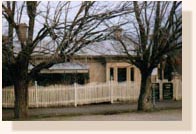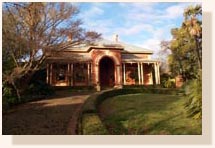Adair House
Bowes' Cottages
Bunya
Calder House
Dickman's Cottage
Dr Hardy's Cottage
Ethandune
Kyndalyn
Holy Trinity Parsonage
Laurel Cottage
Lauriston House
Lisle's Cottage
Minilya
Mount Hawke
Old Post Office
Presbyterian Manse
Robinson's House
Rule's House
School Cottage
Tressider's Cottage
Vivian's House
Warnock's House
Adair House, Adair Street
The land was originally purchased by T Blenkiron in 1861 and
the existing house built c1875
Bowes' Cottages, Peg Leg Gully

The three stone and brick cottages c1860 were built by
William Bowe and Sons. The Bowes came from Cumberland,
England in the mid 1850's. They opened a quarry and built
their homes close to the quarry using its stone for the
buildings and the existing stone fences. The Bowes also were
responsible for a number of the stone constructions in
Maldon. The small house nearest the road was the birthplace
of Colonel E J Bowe, the most senior Australian nurse at the
time of WWII.
Bunya, Long Gully Road

The land was purchased in 1860 and the existing weatherboard
house built around 1895. A notable feature of the house is
the large Bunya tree on the corner.
Calder House, High Street


The land was purchased in 1857 by J Dolphin and was adjoined
by another block with a frontage on Main Street. Thomas
Calder, builder, undertaker, ironmonger, leased the property
and later purchased it and the Main Street property in 1866.
The residence appears to be constructed around 1880. Calder
still occupied the premises in 1900. The building is now
used as a restaurant and accommodation.
Dickman's Cottage, Long Gully Road

(Castlemaine Road, Cnr Sandy Creek Road)
Land was purchased by H Dickman in 1860 and the building was
constructed c1860. The building is notable for the variety
of outbuildings constructed in different materials.
Dr Hardy's Cottage, High Street

The land was purchased by C H Hardy in 1857 and the
weatherboard and brick house was built in the same year. Dr
Hardy had his practice on the site until he sold the
property in 1861.
Ethandune, High Street


The house was constructed around 1870 of rendered brick. It
was occupied from about 1890 by R D Oswald Jnr, the son of
Robert Dent Oswald who owned the North British Mine. Oswald
Jnr returned from a Bank Manager's in Queensland to take
over his business interests. The original circular driveway
leads from the gate to the front porch.
Kyndalyn, Parkins Reef Road

The land was purchased in 1862 and the weatherboard house
constructed around 1866. The building appears to have
operated as a shop in the small village that existed at that
time to the south of Maldon. The house has an interesting
timber valence on the verandah that abuts the front
boundary. The building is a good example of an early miner's
cottage.
Holy Trinity Parsonage, Templeton street

The land was purchased in 1867 and the brick building
constructed by 1868 as the parsonage for the Church of
England. The Rev. J Stretch was the first occupant. The
building backs on to the Denominational School and Church
Hall which was in operation at this time.
Laurel Cottage, Adair Street

The weatherboard cottage was built around 1865 and the land
purchased the following year. The building is a classic
miner's cottage of that time and the additional rooms added
to the original building have been creatively arranged. The
front garden is notable as it retains the original classic
cottage garden design.
Lauriston House, High Street

The building was constructed in 1866 for Robert D Oswald,
the owner of the North British Mine and the Caledonian
Crushing battery. The construction was of stone by
stonemasons W Bowe and Sons with ragstone from their quarry,
but with the front wall constructed from dressed bluestone.
The iron gate and the iron palisade fence are also notable
features. The house is classified by the National Trust.
Lisle's Cottage, High Street

The land was first purchased in 1857 and the brick house was
constructed in 1857. The house was built for Dr Lisle, a
co-owner of the short-lived but rich Lisle's Reef mine. Dr
Lisle left soon after and died penniless in Melbourne. The
house was then occupied by doctors for most of its history.
Minilya, Adair Street

The land was purchased in 1857 and the existing house built
around 1900. The construction is an ornate house in an
imposing position and built of weatherboard on stone
foundations. It was built by Charles Calder for his wife and
soon to be born child. Charles was the son of Thomas Calder
another of the wealthy traders of the town.
Mount Hawke, Adair Street

The land was purchased in 1859 and the original cottage was
constructed around 1860. The building was originally owned
by Samuel Dabb, a wealthy trader of the town, who owned a
number of the larger stores in Main and High Streets. The
building was extended in the 1870's with an unusual
construction of solid brick walls on ragstone foundations,
but with a weatherboard external lining. A ballroom was
added to the house in the 1880's using the same
construction. Antonia Barron's novel, Jeremy Jeremiah,
was set in the house.
Old Post Office, Long Gully Road

The building was constructed in 1855 as a shop and
residence. The first post office operated from a tent until
the position was given to this store. It was used as the
first permanent post office until 1857 when the post office
moved to a building in Main Street.
Presbyterian Manse, Church Street

The land was purchased in 1858 by the Presbyterian Church.
The first weatherboard building on the site was constructed
in 1858 as a temporary residence for the Minister. Two
further brick rooms were added in 1859 and the two visible
brick rooms were added to the house in 1861.
Robinson's House, High Street

The land was purchased in 1859 and the house constructed
prior to 1865. The gothic form of construction is unique in
Maldon, The unusual gables, the timber barge boards and
window trims are an unusual feature.
Rule's House, Adair Street

The land was purchased in 1861 and the large brick house
constructed around 1897. The building appears to have been
constructed by J Rule for his retirement. Rule was the part
owner and legal manager of the South German Mine, the
deepest, and one of the richest mines in Maldon.
School Cottage, High Street

The land was purchased in 1857 and the weatherboard cottage
was built around 1860. The cottage has two wings at the
rear, one of which housed Miss Farley's Private School.
Tressider's Cottage, High Street

The land was purchased in 1857 and the brick cottage
constructed in 1859. This building acted as a landmark in
the earlier descriptions of locations as street numbers are
only a recent addition to Maldon.
Vivian's House, High Street

The land was purchased in 1857 and the brick house and shop
were constructed around 1862. It appears as if the unusual
brickwork around the windows and door were introduced when
the building was altered to a residence in 1868. The
building was owned by Thomas Vivian who carried out his
business in the properties to the rear of the house.
Warnock's House, Spring street

The land was purchased in 1857 and the brick house was
constructed around 1867 for James Warnock, a wealthy trader
who owned the Beehive Store and Flour Mills in High Street.
Alterations were made to the house in 1870.
|